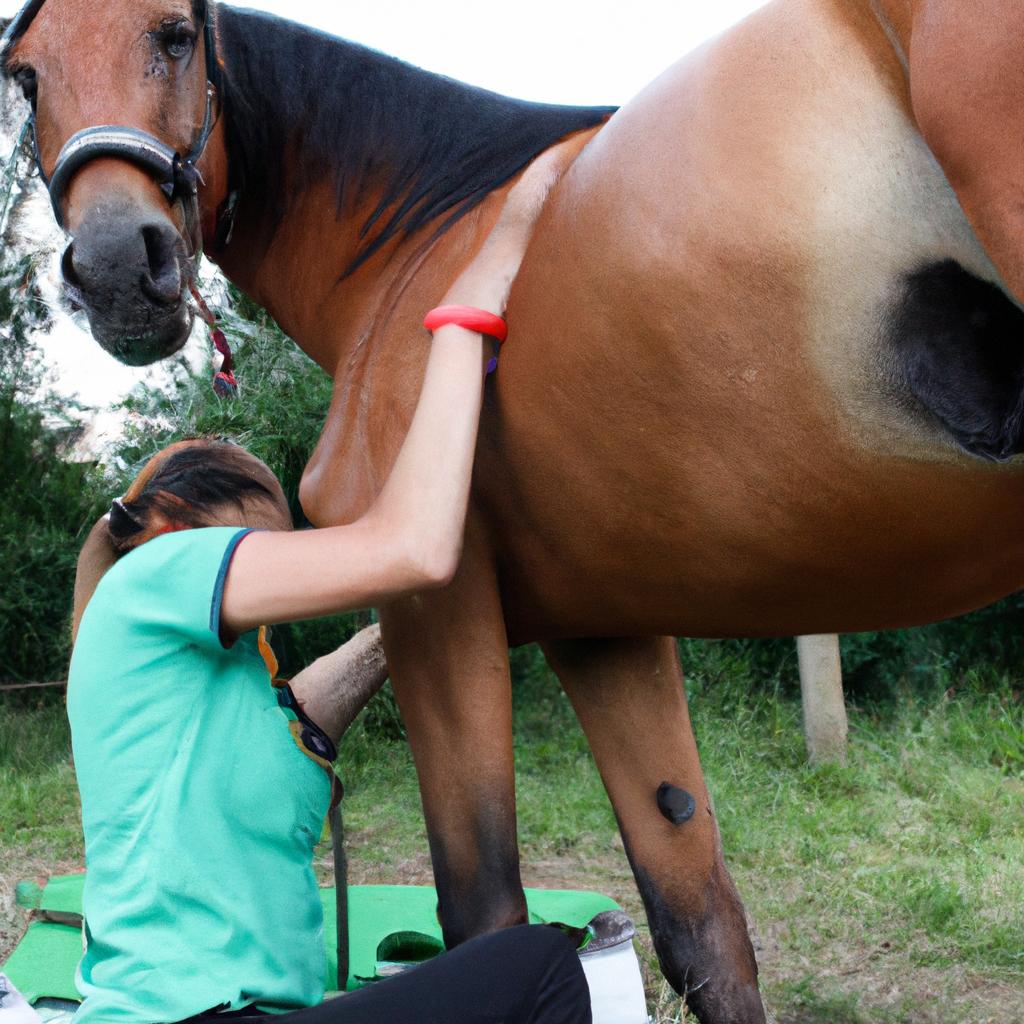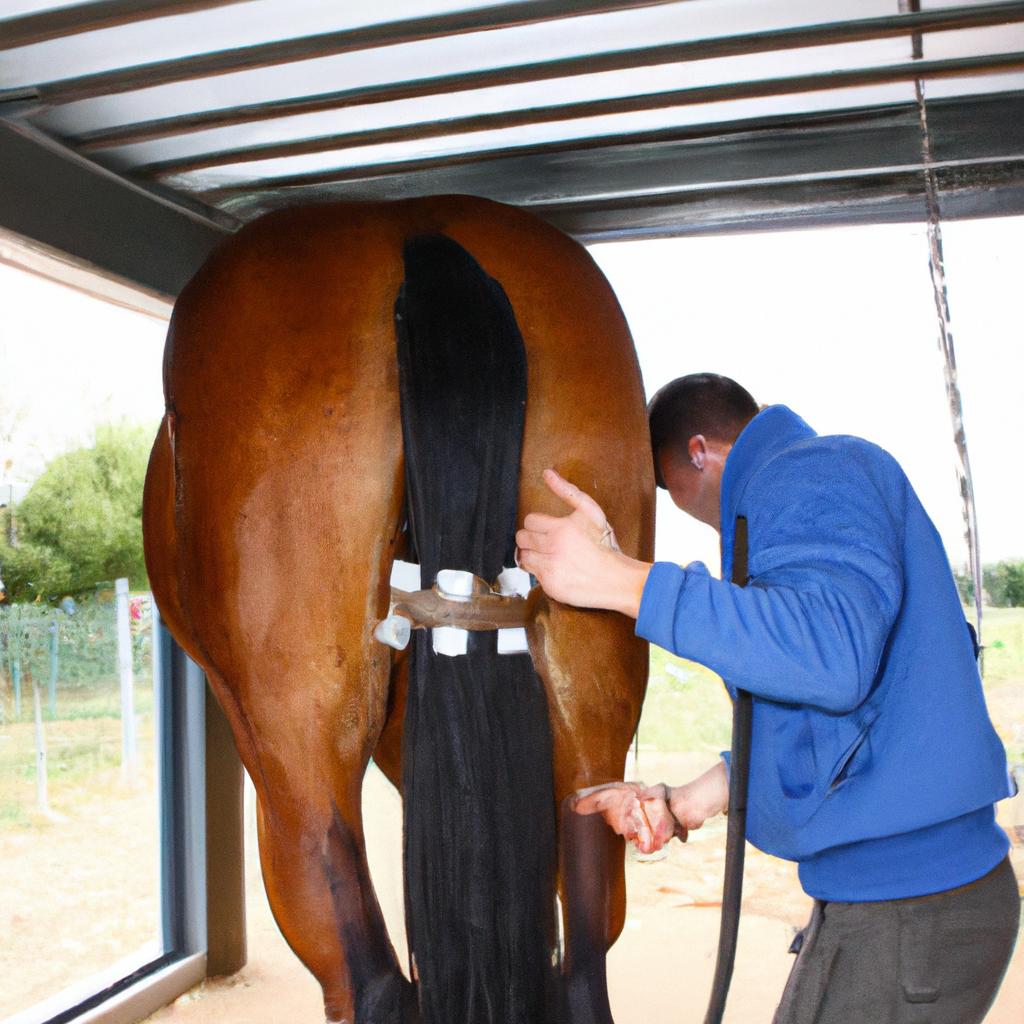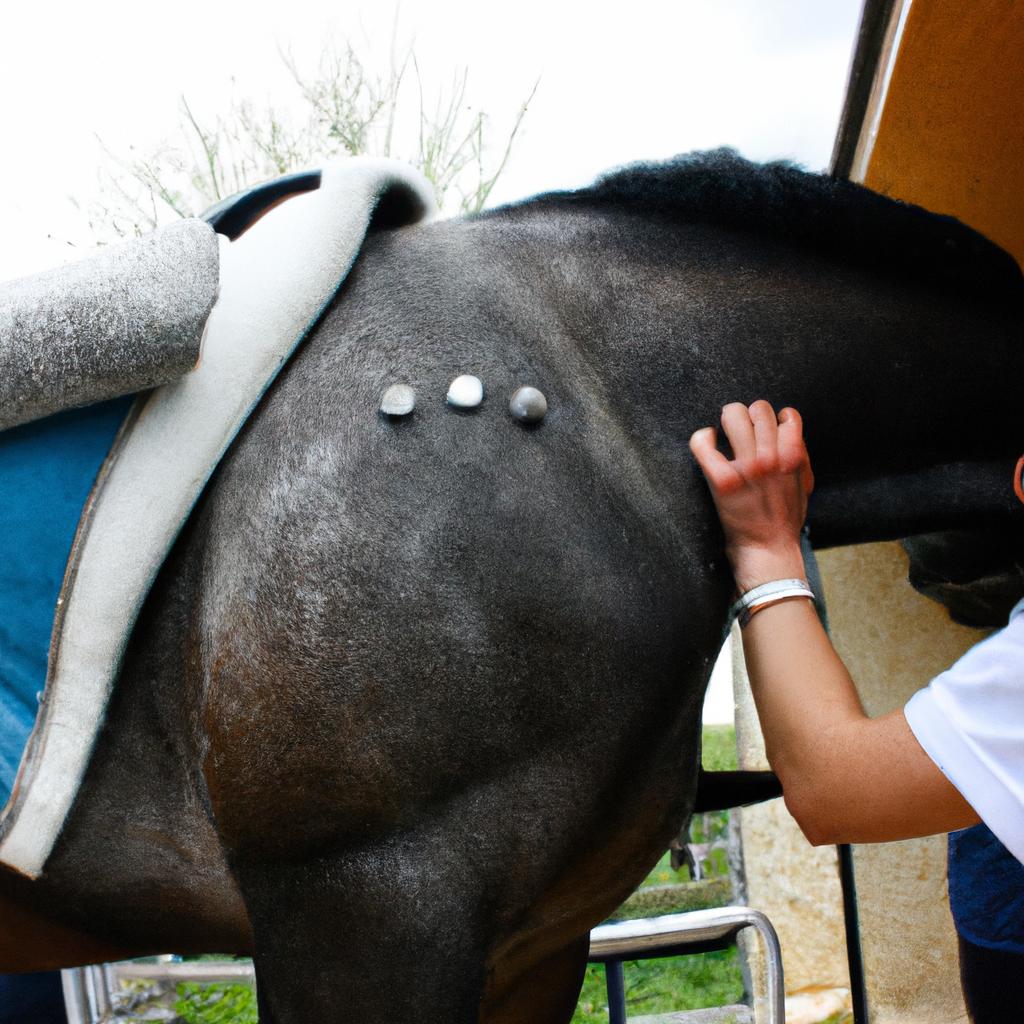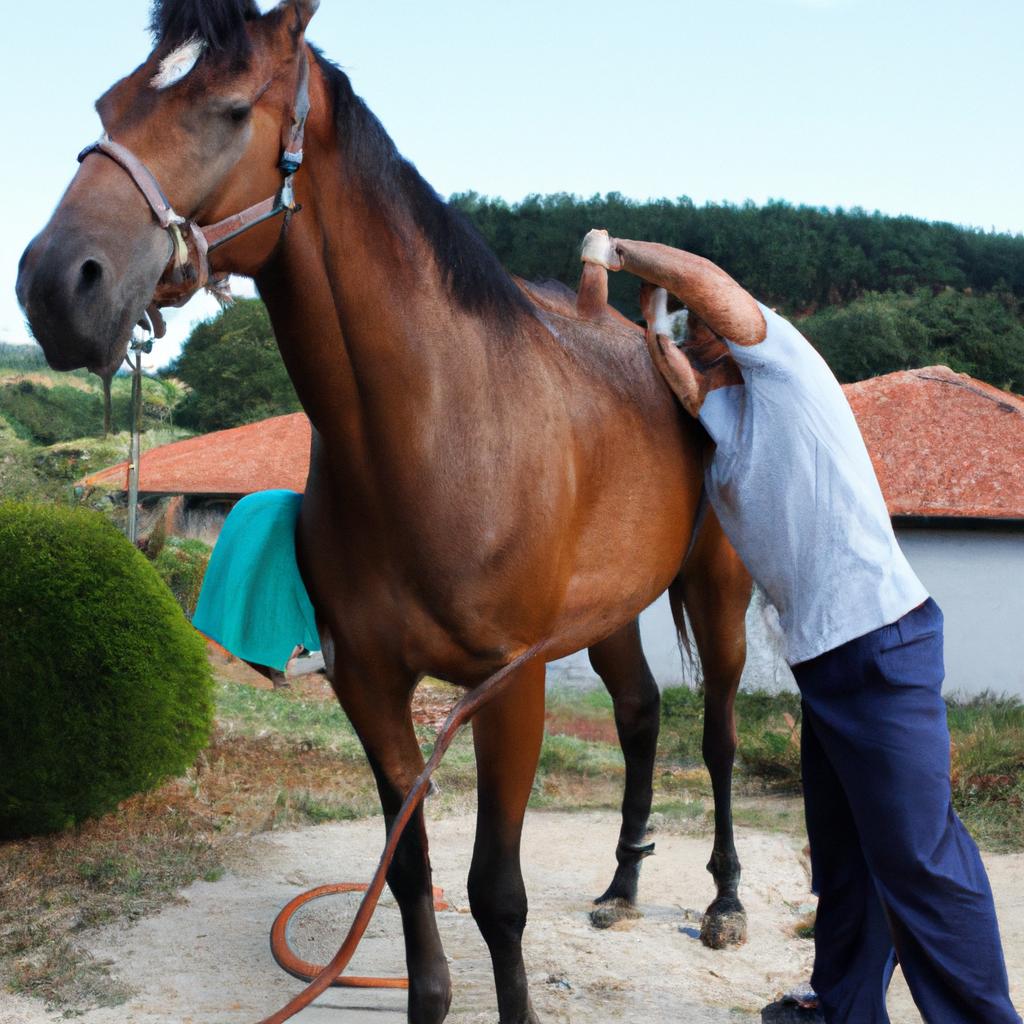Equine chiropractic techniques have gained popularity in recent years as a non-invasive and holistic approach to maintaining the health and well-being of horses. These techniques, similar to those used in human chiropractic care, aim to address musculoskeletal issues in horses by restoring proper spinal alignment and promoting overall body balance. In this article, we will explore common horse chiropractic techniques, their safety considerations, and their effectiveness within the context of chiropractic for horses.
Consider a hypothetical case where a competitive show jumper begins experiencing decreased performance due to recurring lameness. Traditional veterinary treatments only provide temporary relief but fail to address the underlying cause of the issue. In search of an alternative solution, the owner decides to consult an equine chiropractor who performs specific adjustments on the horse’s spine. Over time, the show jumper’s lameness diminishes significantly, allowing them to perform at their peak again. This example highlights how horse chiropractic techniques can potentially provide effective solutions when conventional methods fall short.
When considering equine chiropractic care, it is crucial to examine both its safety aspects and its proven efficacy. By understanding these factors, horse owners can make informed decisions regarding their animals’ healthcare needs. Therefore, this article aims to delve into various commonly employed horse chiropractic techniques, their safety considerations, and the research supporting their effectiveness.
One commonly used technique in equine chiropractic care is spinal manipulation. This involves applying controlled force to specific areas of the horse’s spine to restore proper alignment and mobility. By doing so, it aims to alleviate pain, improve range of motion, and enhance overall performance. Another technique is joint mobilization, which focuses on gently moving joints within their normal range to reduce stiffness and improve flexibility.
When it comes to safety considerations, it is important that horse chiropractors are properly trained and licensed professionals. They should have a thorough understanding of equine anatomy and physiology to ensure safe and effective treatment. It is also crucial that they work alongside veterinarians as part of a comprehensive healthcare team for the horse.
As for the effectiveness of equine chiropractic techniques, there is growing evidence supporting their benefits. Research studies have shown improvements in gait symmetry, stride length, and back flexibility following chiropractic adjustments in horses. Additionally, many anecdotal reports from horse owners attest to the positive impact of chiropractic care on their animals’ well-being.
However, it is important to note that while equine chiropractic techniques can be beneficial for certain conditions, they may not be suitable or effective for all horses or issues. Each case should be evaluated individually by a qualified professional who can determine if chiropractic care is appropriate and likely to provide desired results.
In conclusion, equine chiropractic techniques offer a non-invasive approach to addressing musculoskeletal issues in horses. When performed by trained professionals and integrated into a comprehensive healthcare plan with veterinary oversight, these techniques can potentially help improve performance and overall well-being in horses. However, individual cases should always be assessed by professionals who can tailor treatment plans based on each horse’s unique needs.
Understanding Horse Anatomy
Imagine a horse named Bella, who spends her days gracefully galloping through open fields. To understand the impact of chiropractic techniques on horses like Bella, it is essential to have a solid grasp of their anatomy and biomechanics. By exploring the intricate structure and function of a horse’s body, we can appreciate how these techniques can be both safe and effective in addressing common equine health issues.
Key Aspects of Horse Anatomy:
-
Skeletal System: The skeletal system provides the framework for a horse’s body, supporting its weight and facilitating movement. A horse’s skeleton consists of several hundred bones connected by joints, which allow for flexibility during locomotion. For example, when Bella trots or jumps over obstacles, her shoulder joint enables smooth motion while bearing significant loads.
-
Muscular System: Complementing the skeletal system is the muscular system that allows for powerful movements in horses. Strong muscles are crucial for propulsion and maintaining balance during various activities such as running or jumping. In fact, research has shown that well-developed core muscles contribute to enhanced performance and reduced risk of injury in horses.
-
Nervous System: The nervous system plays a vital role in coordinating all bodily functions and responses to stimuli. Horses rely on their highly developed senses to react swiftly to potential dangers or changes in their environment. This coordination between the central nervous system and peripheral nerves ensures proper motor control and sensory perception.
-
Circulatory System: Just like humans, horses possess an efficient circulatory system responsible for transporting oxygen-rich blood throughout their bodies. Adequate blood supply nourishes tissues and organs, ensuring optimal functioning throughout the horse’s anatomy.
Emotional Response Bullet Points:
- Improved understanding of horse anatomy leads to more informed decision-making regarding their healthcare.
- Appreciating the complexity of a horse’s anatomical systems fosters empathy towards these magnificent creatures.
- Recognizing the interplay between different anatomical components can inspire awe and admiration for the equine body.
- By understanding horse anatomy, we can better appreciate the value of specialized chiropractic techniques in maintaining their overall well-being.
Emotional Response Table:
| Aspects | Impact |
|---|---|
| Skeletal System | Provides structural support during locomotion |
| Muscular System | Enables powerful movements and balance |
| Nervous System | Coordinates motor control and sensory perception |
| Circulatory System | Ensures optimal functioning throughout the body |
A comprehensive knowledge of horse anatomy is fundamental when considering chiropractic interventions. Understanding how a horse’s skeletal, muscular, nervous, and circulatory systems interact provides a solid foundation for assessing common equine health issues. In the following section on “Identifying Common Horse Chiropractic Issues,” we will explore specific conditions that may benefit from targeted chiropractic care.
Identifying Common Horse Chiropractic Issues
Understanding Horse Anatomy plays a crucial role in applying chiropractic techniques effectively and safely. By having a comprehensive knowledge of the horse’s musculoskeletal system, practitioners can identify potential issues and develop appropriate treatment plans. This section will explore common horse chiropractic issues that arise due to anatomical factors.
One example of an issue related to horse anatomy is vertebral misalignment. In this scenario, a misaligned vertebra can lead to restricted movement, muscle tension, and pain for the horse. Chiropractic adjustments aim to restore proper alignment, thereby alleviating discomfort and improving overall mobility.
To further understand the various anatomical aspects influencing chiropractic treatment for horses, consider the following bullet points:
- The importance of spinal health in maintaining optimal performance.
- How joint structure affects range of motion and flexibility.
- The connection between muscular strength and stability.
- The impact of biomechanics on posture and gait.
These points highlight the intricate relationship between anatomy and chiropractic care. Understanding these connections allows practitioners to tailor their interventions based on individual needs while maximizing therapeutic benefits.
Table: Common Anatomical Factors Affecting Horse Chiropractic Treatment
| Factor | Influence |
|---|---|
| Spinal Alignment | Maintains optimal performance |
| Joint Structure | Affects range of motion and flexibility |
| Muscular Strength | Provides stability |
| Biomechanics | Influences posture and gait |
In summary, recognizing how anatomy influences chiropractic treatment enables practitioners to address specific issues more efficiently. By restoring proper alignment, enhancing joint function, promoting muscle balance, and optimizing biomechanics, they can improve the overall well-being of horses under their care. With an understanding of these anatomical considerations established, it becomes essential to discuss the preparation required before initiating any chiropractic treatment for horses – a topic we will delve into in the subsequent section about “Preparation for Chiropractic Treatment.”
Preparation for Chiropractic Treatment
In our examination of common horse chiropractic issues, let us consider the case of a competitive show jumper named Bella. Bella is a 10-year-old mare who has been experiencing difficulty with her hind limbs during jumps. Upon observation, it becomes evident that she exhibits signs of stiffness and discomfort in her lower back and pelvis region. This scenario serves as an example to highlight the importance of identifying common chiropractic issues in horses.
When assessing potential chiropractic problems in horses, several key indicators can help guide practitioners. These indicators include changes in behavior or performance, such as noticeable lameness or reluctance to perform certain movements. Additionally, physical examinations may reveal asymmetry or misalignment in the spine or joints, which can contribute to pain and restricted range of motion for the horse. Identifying these issues early on allows for prompt intervention and treatment to alleviate any discomfort experienced by the animal.
To further emphasize the significance of addressing equine chiropractic concerns promptly, consider the following emotional impact:
- A horse owner witnessing their beloved companion struggling with pain during activities they once enjoyed together.
- The frustration felt when attempts at traditional veterinary care fail to provide relief.
- The sense of hope and relief upon discovering that chiropractic techniques may offer a solution.
- The joy experienced when witnessing their horse regain comfort and mobility through successful chiropractic treatment.
The table below summarizes some common symptoms associated with equine chiropractic issues:
| Symptoms | Description |
|---|---|
| Stiffness | Difficulty moving freely or exhibiting resistance in movement |
| Lameness | Visible limping or uneven gait |
| Reduced Performance | Decreased ability to perform tasks previously accomplished easily |
| Behavioral Changes | Altered temperament or unwillingness to engage |
By recognizing these symptoms and understanding their emotional impact on both horse owners and animals alike, we acknowledge the necessity of addressing common horse chiropractic issues. In the subsequent section, we will explore the preparation required before undertaking chiropractic treatment for horses, including considerations such as proper equipment and environment.
Transitioning into the next section about “Different Chiropractic Techniques for Horses,” it is important to understand how these techniques can be effectively applied in addressing equine chiropractic concerns.
Different Chiropractic Techniques for Horses
Having discussed the importance of preparation in the previous section, let us now explore the various chiropractic techniques commonly employed in equine practice. Understanding these different techniques is crucial as it allows veterinarians and horse owners to make informed decisions about which approach may be most suitable for their horses’ specific needs.
Paragraph 1: One widely used technique is spinal manipulation, wherein a veterinarian applies controlled force to specific areas of the horse’s spine. This helps restore joint mobility, reduce pain, and improve overall musculoskeletal function. For instance, consider a hypothetical case study of a dressage horse experiencing stiffness and difficulty performing lateral movements due to restricted range of motion in its neck joints. By employing spinal manipulation techniques such as diversified adjusting or activator methods, the veterinarian can target those affected joints and potentially alleviate the horse’s discomfort while enhancing its performance.
Paragraph 2:
To broaden our understanding further, here are some common chiropractic techniques utilized for horses:
- Flexion-distraction technique: Involves gentle stretching and flexing motions applied to vertebrae.
- Gonstead technique: Focuses on assessing misalignments through palpation before delivering precise adjustments.
- Sacroiliac (SI) mobilization: Addresses imbalances between the pelvis and sacrum by applying manual pressure or using specialized tools.
- Soft tissue therapy: Complements chiropractic care with massage techniques aimed at relieving muscle tension and promoting relaxation.
These approaches serve as valuable tools within an equine chiropractor’s repertoire, allowing them to tailor treatments according to individual horse requirements.
| Technique | Description |
|---|---|
| Spinal Manipulation | Controlled force applied to specific areas of the spine to enhance joint mobility and reduce pain |
| Flexion-Distraction | Gentle stretching and flexing motions targeted at vertebrae |
| Gonstead | Assessment of misalignments through palpation followed by precise adjustments |
| Sacroiliac (SI) Mobilization | Addressing imbalances between the pelvis and sacrum using manual pressure or specialized tools |
| Soft Tissue Therapy | Massage techniques to alleviate muscle tension, complementing chiropractic care |
Paragraph 3:
Understanding the variety of chiropractic techniques available for horses is essential for ensuring their safety and effectiveness. While each technique has its unique benefits, it is crucial to consult with a qualified equine chiropractor who can assess the horse’s condition and recommend an appropriate approach. By selecting the most suitable technique, veterinarians and horse owners can optimize treatment outcomes while prioritizing the well-being of these magnificent animals.
As we have explored different chiropractic techniques employed in equine practice, let us now delve into evaluating their effectiveness in promoting overall health and well-being in horses.
Evaluating the Effectiveness of Chiropractic Treatment
Common Horse Chiropractic Techniques: Safety and Effectiveness in the Context of Chiropractic for Horses
Different Chiropractic Techniques for Horses have proven to be valuable in addressing various musculoskeletal issues. One commonly used technique is spinal manipulation, where a chiropractor applies controlled force to specific areas of the horse’s spine with the aim of restoring movement and alleviating pain. For instance, consider a hypothetical scenario where a racehorse named Thunder has been experiencing stiffness in its back after intense training sessions. In this case, a chiropractor might employ spinal manipulation techniques to improve Thunder’s flexibility and overall performance.
When it comes to Common Horse Chiropractic Techniques, there are several methods that practitioners may utilize:
- Spinal Manipulation: As mentioned earlier, this involves applying precisely directed force to targeted areas of the horse’s spine.
- Joint Mobilization: This technique focuses on increasing joint range of motion by gently moving the joints through their natural planes.
- Soft Tissue Release: By manipulating muscles, tendons, and ligaments, soft tissue release aims to reduce tension and alleviate discomfort.
- Stretching Exercises: Specific stretching exercises can help horses regain or enhance their flexibility while improving overall muscle tone.
Here is an example table showcasing different common chiropractic techniques along with their intended benefits:
| Technique | Intended Benefit |
|---|---|
| Spinal Manipulation | Restoring spinal mobility |
| Joint Mobilization | Increasing joint range of motion |
| Soft Tissue Release | Reducing muscle tension |
| Stretching Exercises | Enhancing flexibility and muscle tone |
These techniques should always be performed by qualified professionals who understand equine biomechanics and possess thorough knowledge about horse anatomy. Additionally, it is crucial that veterinarians work closely with chiropractors to ensure comprehensive care for the horse.
In light of these considerations regarding Common Horse Chiropractic Techniques’ safety and effectiveness, it is essential to recognize that selecting a qualified chiropractor is paramount. In the subsequent section about “Considerations for Choosing a Horse Chiropractor,” we will discuss crucial factors to keep in mind when seeking professional assistance for your horse’s chiropractic needs.
Considerations for Choosing a Horse Chiropractor
In order to evaluate the effectiveness of chiropractic treatment for horses, it is important to consider both anecdotal evidence and scientific research. While anecdotal evidence provides valuable insights into individual cases, scientific research allows for a more objective assessment of the overall effectiveness of these techniques.
One example that highlights the potential benefits of horse chiropractic treatment involves a competitive dressage horse who was experiencing stiffness and difficulty performing certain movements. After receiving regular chiropractic adjustments, the horse showed significant improvement in flexibility and performance. This case study suggests that chiropractic treatment may be beneficial in improving range of motion and overall athletic performance in horses.
To further understand the effectiveness of chiropractic treatment for horses, several key considerations should be taken into account:
- Study design: Research studies evaluating chiropractic treatments should utilize appropriate experimental designs such as randomized controlled trials or comparative observational studies to ensure reliable results.
- Sample size: The number of animals included in a study can greatly influence its validity. Larger sample sizes provide more statistically robust findings.
- Outcome measures: Objective outcome measures, such as gait analysis or biofeedback measurements, should be used to assess improvements resulting from chiropractic interventions.
- Long-term follow-up: Evaluating the long-term effects of chiropractic treatment is crucial to understanding its lasting impact on equine health and well-being.
Table 1 showcases examples of recent research studies investigating the effectiveness of horse chiropractic treatments:
| Study | Design | Sample Size | Outcome Measures |
|---|---|---|---|
| A | RCT | 50 horses | Gait Analysis |
| B | Observational Comparative | 100 horses | Biofeedback Measurements |
| C | Case-control | 30 horses | Range of Motion Assessment |
The table demonstrates the diversity in study designs, sample sizes, and outcome measures used to evaluate the effectiveness of chiropractic treatments for horses. These studies provide valuable insights into the potential benefits and limitations of this therapeutic approach.
In summary, evaluating the effectiveness of horse chiropractic treatment requires a combination of anecdotal evidence and scientific research. A case study example illustrates the positive impact that chiropractic adjustments can have on equine performance. To ensure reliable results, future research should employ appropriate study designs, consider sample size, utilize objective outcome measures, and incorporate long-term follow-up assessments. By considering these factors, we can gain a more comprehensive understanding of the safety and effectiveness of chiropractic techniques in the context of horse care and well-being.
 Eq Muscle Release
Eq Muscle Release



